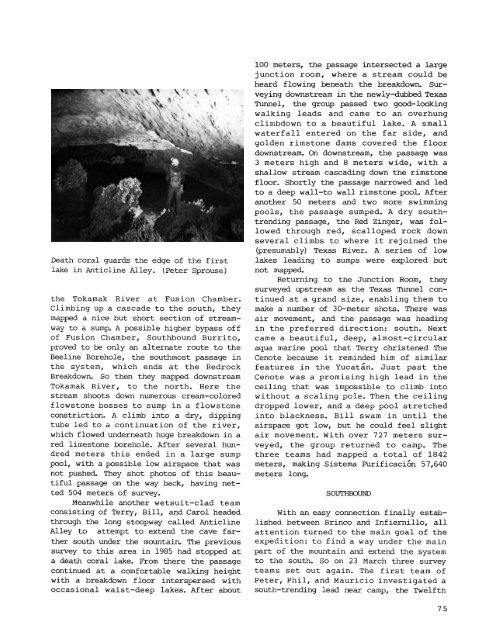8MB PDF - Association for Mexican Cave Studies
8MB PDF - Association for Mexican Cave Studies
8MB PDF - Association for Mexican Cave Studies
- No tags were found...
Create successful ePaper yourself
Turn your PDF publications into a flip-book with our unique Google optimized e-Paper software.
Death coral guards the edge of the firstlake in Anticline Alley. (Peter Sprouse)the Tokamak River at Fusion Chamber.Climbing up a cascade to the south, theymapped a nice but short section of streamwayto a sump. A possible higher bypass offof Fusion Chamber, Southbound Burrito,proved to be only an alternate route to theBeeline Borehole, the southmost passage inthe system, which ends at the RedrockBreakdown. So then they mapped downstreamTokamak River, to the north. Here thestream shoots down numerous cream-coloredflowstone bosses to sump in a flowstoneconstriction. A climb into a dry, dippingtube led to a continuation of the river,which flowed underneath huge breakdown in ared limestone borehole. After several hundredmeters this ended in a large sumppool, with a possible low airspace that wasnot pushed. They shot photos of this beautifulpassage on the way back, having netted504 meters of survey.Meanwhile another wetsuit-clad teamconsisting of Terry, Bill, and Carol headedthrough the long stoopway called AnticlineAlley to attempt to extend the cave farthersouth under the mountain. The previoussurvey to this area in 1985 had stopped ata death coral lake. From there the passagecontinued at a com<strong>for</strong>table walking heightwith a breakdown floor interspersed withoccasional waist-deep lakes. After about100 meters, the passage intersected a largejunction room, where a stream could beheard flowing beneath the breakdown. Surveyingdownstream in the newly-dubbed TexasTunnel, the group passed two good-lookingwalking leads and came to an overhungclimbdown to a beautiful lake. A smallwaterfall entered on the far side, andgolden rimstone dams covered the floordownstream. On downstream, the passage was3 meters high and 8 meters wide, with ashallow stream cascading down the rimstonefloor. Shortly the passage narrowed and ledto a deep wall-to wall rimstone pool. Afteranother 50 meters and two more swimmingpools, the passage sumped. A dry southtrendingpassage, the Red Zinger, was followedthrough red, scalloped rock downseveral climbs to where it rejoined the(presumably) Texas River. A series of lowlakes leading to sumps were explored butnot mapped.Returning to the Junction Room, theysurveyed upstream as the Texas Tunnel continuedat a grand size, enabling them tomake a number of 3D-meter shots. There wasair movement, and the passage was headingin the preferred direction: south. Nextcame a beautiful, deep, almost-circularaqua marine pool that Terry christened TheCenote because it reminded him of similarfeatures in the Yucatan. Just past theCenote was a promising high lead in theceiling that was impossible to climb intowithout a scaling pole. Then the ceilingdropped lower, and a deep pool stretchedinto blackness. Bill swam in until theairspace got low, but he could feel slightair movement. With over 727 meters surveyed,the group returned to camp. Thethree teams had mapped a total of 1842meters, making Sistema Purificacioo 57,640meters long.SOUTHBOUNDWith an easy connection finally establishedbetween Brinco and Infiernillo, allattention turned to the main goal of theexpedition: to find a way under the mainpart of the mountain and extend the systemto the south. So on 23 March three surveyteams set out again. The first team ofPeter, Phil, and Mauricio investigated asouth-trending lead near camp, the Twelfth75
















